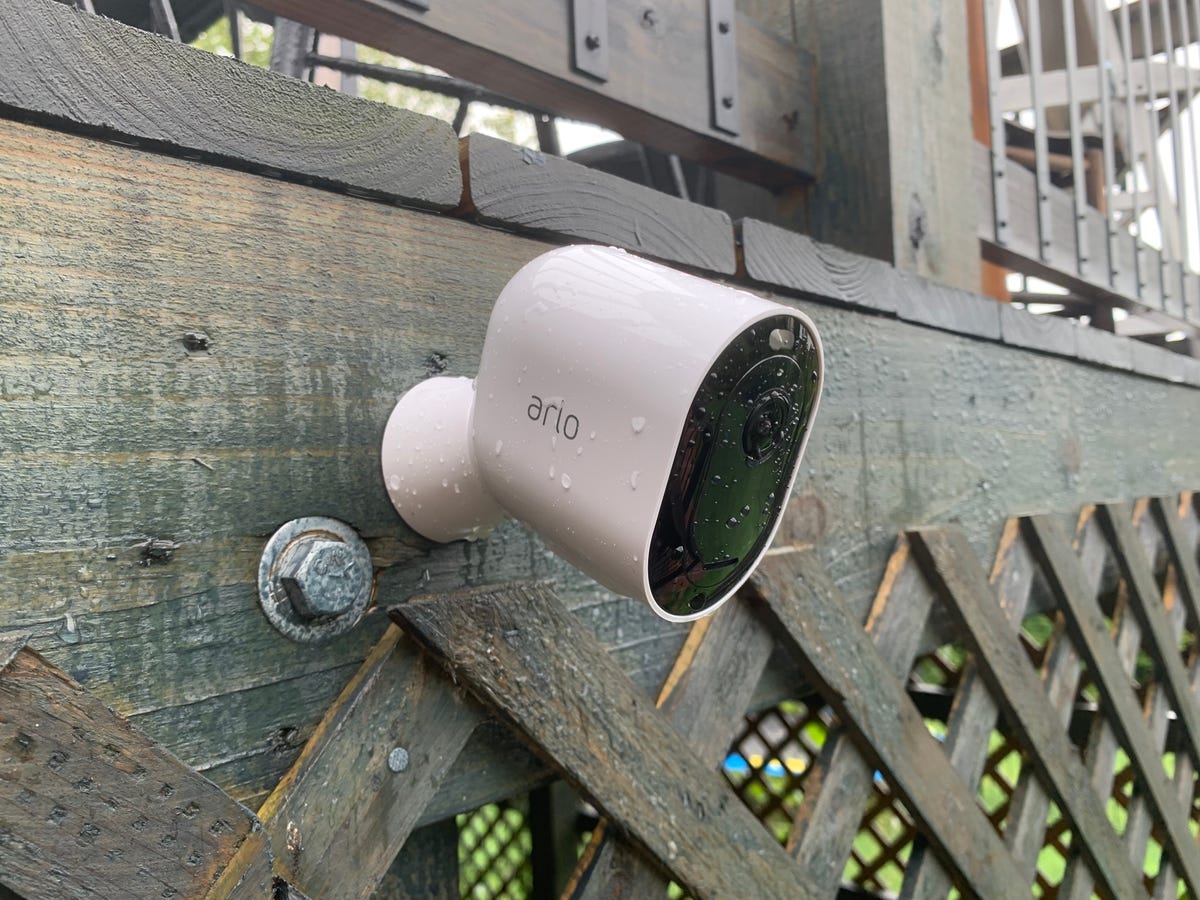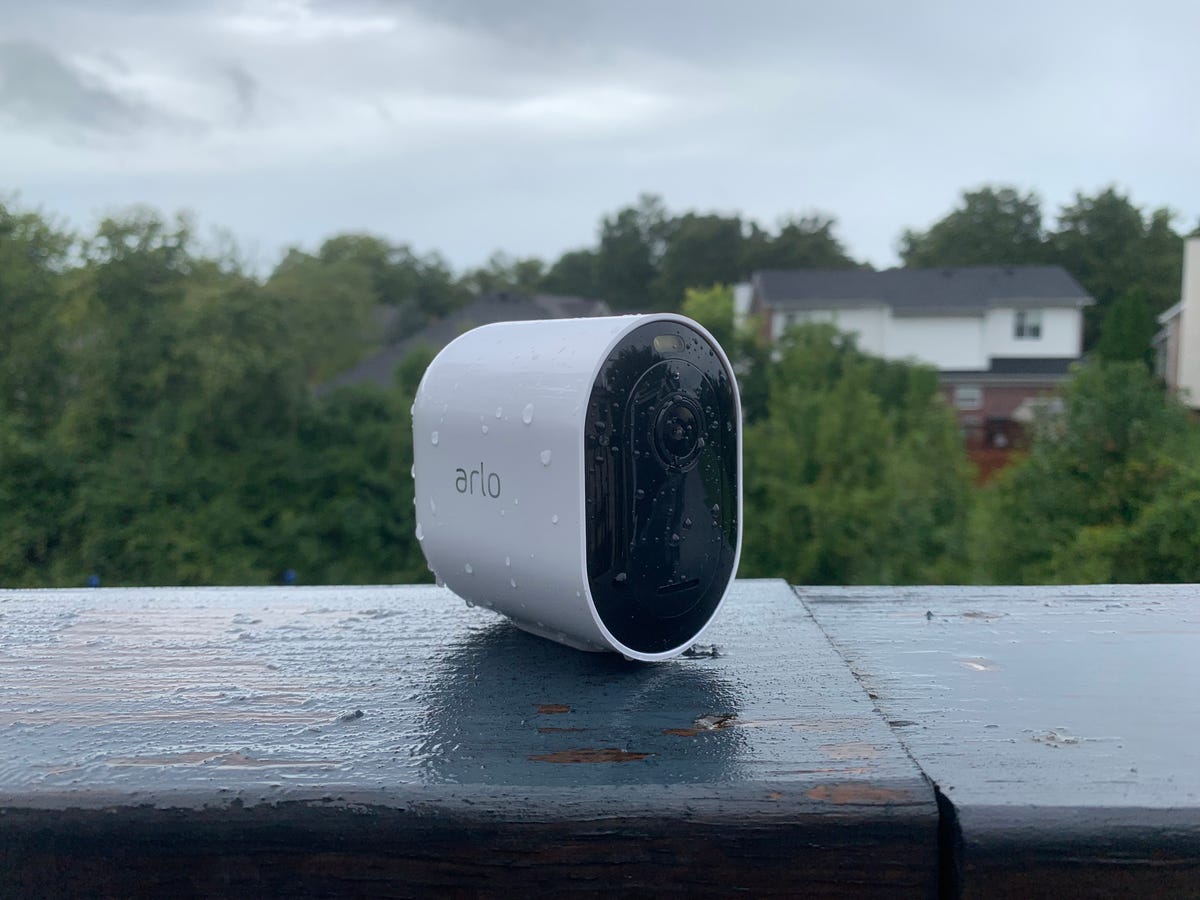Like
- Excellent performance
- Siren and spotlight
- Solid design
Don’t Like
- Barriers to HomeKit compatibility
- Limited free features
In this article:
Considering the Arlo Pro 4 in 2023?
Arlo released its popular Pro 4 wireless outdoor camera in October 2020. We tested it out in September of the following year and were impressed with its features and performance, enough so to give our Editor’s Choice award and name it as our pick for best outdoor camera overall. Today, the camera still stands as one of our most recommended outdoor cameras, even with the relatively high price of $200.
That said, we haven’t tested out the new Arlo Pro 5 yet, either. The newer model is slightly more expensive (standard price is $250), but the added features — dual band Wi-Fi, low power mode for extended battery life and enhanced security — may be worth the extra cost. And if you can find it on sale for the same price or lower than the Arlo Pro 4, the Pro 5 seems like the obvious choice.
If, however, you’re still interested in the Arlo Pro 4 and how it performs, you can read our full review, originally published Sept. 23, 2021, below:
Arlo Pro 4 review
Outdoor security cameras are getting more affordable all the time, with options as cheap as $35. And yet we still see cameras in the $200 range, from leading brands like Google Nest and Arlo, no less.
The Arlo Pro 4 shows us why.
With a rich set of features, dependable design and a competitive subscription service, the Pro 4 is our favorite outdoor camera on the market at $200. No, it’s not the most affordable device out there, but no competitors can beat the Pro 4’s versatility and all-around performance for the price.
Who should buy the Pro 4? Almost anyone looking to buy an outdoor security camera.

The Arlo Pro 4 is easy to set up, and easy to use
From unboxing to monitoring my backyard, the Arlo Pro 4 took less than 10 minutes to set up. The majority of that time was taken up by a software update. Otherwise, I connected the camera to my Arlo app in less than a minute and mounted the magnetic base to a spot on my deck in under two. (Granted, I keep a power drill handy at all times, given how often I install gadgets like this around the house.)
From there, I was able to start testing out the Pro 4’s features right away, manually switching the spotlight on and off to see the difference (bright enough during the night), triggering the siren to see how loud it is (loud, but not deafening) and zooming into various corners of the live-streaming video.
The Arlo app is simple and straightforward, with all the features I want to toggle easily accessible on the live stream screen. In the settings, you can also fiddle with a slew of other tools, like auto zoom & tracking, power management settings and activity zones (with a subscription).
Unlike the Pro 3 — and other cameras from generations past — the Pro 4 connects directly to your Wi-Fi, which is convenient, since you won’t need a separate hub. But it made me a little nervous about the impact on battery life: Wi-Fi is less energy efficient than other communication protocols, like Bluetooth or Zigbee. Arlo says the battery should last between three and six months per charge, which is fairly standard among wireless cameras. Over the course of a week and a half of testing, though, the Pro 4 only went down about 5% — which put the battery life on track for about seven months for me. That’s really solid, and since it only takes about five hours to charge, your monitoring should remain nearly uninterrupted year-round, even if it’s a little less efficient than it seems.
No keys: Push to start
The Arlo Pro 4 is like a fully upgraded electric car: It makes you feel fancy and it’s practical. The camera itself has a nice heft to it and sticks solidly to the magnetic base. It boasts 2K resolution, a 160-degree field of view, full-color night vision (though it shifts to black and white in truly low-light settings), two-way talk, a built-in siren and motion-sensitive spotlight — the works.
Nest’s most recent outdoor camera, by comparison, has 1080p resolution, a 130-degree field of view, standard night vision, two-way talk and neither a siren nor a spotlight. Sure, it costs $20 less at $180, but ends up more expensive over time if you factor in subscription fees. In short, the Arlo Pro 4 really packs in the features.
Needless to say, the Pro 4 also easily beats out budget options — like the excellent-for-the-price $35 Wyze Cam v3 — which often don’t come with lights, sirens, 2K resolution or wide-angle fields of view.
The one thing Wyze has that few other companies offer is 14 days of free cloud storage. Which brings me to my one criticism of Arlo: the lack of subscription-free features.
It’s no secret that smart security camera developers want to hook you with a monthly subscription. Free trials abound here — Wyze and Google Nest both offer a free month, while Arlo offers a generous three months. The intent is always to get you to end up paying over time.
If you’re allergic to more subscription services like I am, then you might want to buy a camera that will work well enough to avoid the monthly fees. The Arlo Pro 4 really isn’t that: Without paying for Arlo Secure, you lose out on smart alerts, event history and a handful of other features.
Nest, by contrast, offers person, vehicle and animal alerts for free, along with three hours of event history (that’s paltry, but it’s something). Wyze is much more useful without a subscription, with those 14 days of cloud storage for events.
In addition, the Pro 4 doesn’t have an SD card slot, which means any local storage will require a separate device… like the Arlo SmartHub (more on this later).

The Arlo Pro 4 is weather resistant. Don’t submerge it in water; otherwise, it should perform admirably.
David Priest/CNET
Arlo subscribers are the winners
If you’re buying a smart security camera, you may already know that subscriptions are usually an important part of the calculus. And with Arlo, you get a solid deal. Arlo Secure costs $3 per month for a single camera ($10 for unlimited cameras) and nets you object detection (person, vehicle, animal and package), single-button emergency response services, activity zones, video previews in your phone notifications (much like Ring’s much-promoted Rich Notifications feature) — and perhaps most importantly, 30 days of event history.
Three bucks per month is reasonable for this, and in line with competitors like Ring — which charges the same for comparable features. Google Nest charges $6 per month (which is why the $180 Nest Cam will end up costing most people more within 7 months of purchase than the Arlo Pro 4). Nest Aware also comes with other features, though, like facial recognition, and it costs $6 regardless of how many cameras you use.
For my part, I like the scalability of Arlo’s subscription pricing, but for some people, Google’s might make more sense.
Arlo in the smart home
Arlo works well with Google Assistant and Amazon Alexa. When I tested the camera with Alexa, for instance, calling up the live stream on my Echo Show 8 and using two-way talk, it worked quickly and effectively. All I had to say was, “Alexa, show me my camera,” and moments later I was watching a livestream of my backyard.
On the other hand, to take advantage of Apple HomeKit (which Arlo technically does work with), you’ll need a separate Arlo device called the SmartHub. Yes, the same one necessary for local storage. The problem is the SmartHub isn’t available at retailers and hasn’t been for months. I’ve had readers reach out to me about the hub and have asked Arlo in the past for comments on the device’s availability: The company said it’s not discontinued, but declined to tell me when it will be available again.
For HomeKit users, that barrier is a real bummer that stops Arlo from running away with all the awards for smart home compatibility. You know, all those awards that I definitely didn’t just make up.
That said, easy usability with Google Assistant and Amazon Alexa is a nice perk for many users.
Still great, but facing tough competition
The Arlo Pro 4 has emerged as the outdoor security camera leader in a few important respects: First, its spotlight and siren add a level of security deterrence that other cameras in the same price range don’t often match; second, its integration with Google Assistant and Amazon Alexa (and to a lesser degree Apple HomeKit) truly make it more smart home-friendly across different ecosystems.
More importantly than either of these features, however, is just the general quality with which the Pro 4 was designed. It’s a great camera with almost no real weaknesses. In a point-by-point comparison — resolution, performance, battery life and so on — it just consistently outshines the competition. Where it falters, most people simply won’t notice, or mind the slight drawbacks.
If you’re a HomeKit loyalist or looking for a home security camera to use without a subscription, Arlo’s Pro 4 might not be the best option for you. Otherwise, it’s our favorite outdoor smart cam on the market.
For home security tips, check out six places every home should have security cameras, how to prevent your home security cameras from being hacked, and the best cheap home security systems you can buy.
Arlo Pro 4 Security Camera Review: A Top Outdoor Security Camera – CNET
Source: Media Star Philippines


0 Comments